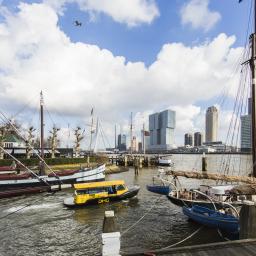Carola Hein, Professor of History of Architecture and Urban Planning TU Delft, has been affiliated with the Institute of Cultural Anthropology and Development Sociology of Leiden University and the Erasmus School of History, Culture and Communication since January 2022 as Professor Water, Ports, and Historic Cities. On the surface this may seem a strange combination, but for Hein it makes sense: 'Without an understanding of the past and present, we are not able to design future scenarios.'

Hein is the driving force behind the Leiden-Delft-Erasmus PortCityFutures programme and since January she is not only a professor at TU Delft, but also at Leiden University and Erasmus University Rotterdam. This is the first time a professor is appointed as Leiden-Delft-Erasmus professor.
Since the beginning of this year, Hein was also awarded the Unesco Chair in 'Water, Ports and Historic Cities', which forms the basis for this LDE double appointment. Hein is looking forward to it: 'I think it's great and a bit exciting, but mostly I see opportunities to bring different worlds together.'
In order to design future scenarios, we must first understand the past and present.’
Educating a new generation of professionals
“In order to design future scenarios, we must first understand the past and present,” says Hein. ‘This is not always obvious for engineers at TU Delft. The students do a lot with ethnography of architecture or interviews, but they are not entirely aware of what it means to do research with people.'
Hein sees great opportunities in her new position for collaboration with anthropology students who have experience with ethnographic research. ‘The idea is to bring the different institutes together and make interdisciplinary research possible. The disciplines can learn a lot from each other. That is good for the future generation of professionals.”
Anthropologists, planners, architects and designers have a lot to learn from each other’s approaches and entanglements in professional and research practices.’
 Connection between social sciences and design
Connection between social sciences and design
In what way do anthropologists benefit from such a collaboration? According to Hein, anyone who writes about design, such as future anthropologists, must have held a pencil at a certain point in order to properly understand the design process.
Hein: ‘Anthropologists explore power structures, including ones that architects and planners participate in. Planners may support the transformation of a neighborhood in line with a goal of urban revitalisation.'
'Anthropologists may look at the same transformation, and their closer eye to power dynamics in decision processes can lead them to examine the developments in terms of gentrification. Anthropologists, planners, architects and designers have a lot to learn from each other’s approaches and entanglements in professional and research practices.’ The connection between design and social sciences is a key issue for Hein.
If we want a better society, we will first have to understand how it functions and determine what a better society is.'
Understanding how society works
When Hein is convinced of something, she tries to get it done. The PortCityFutures programme is a great example: If you want a port to function better, you have engineers who perform very well. In the eyes of the management of a port the critical eye of an anthropologist does not immediately contribute to economic benefits. In that sense it is sometimes difficult to find a connection.
Hein: 'If we want a better society, we will first have to understand how it functions and determine what a better society is. I am very pleased that this view is shared by CADS.’

New minor (Re)Imagining Port Cities
Hein loves the interaction with students. ‘I learn best when I teach. Surprising questions make me happy, which lead to interesting conversations.' She hopes to encounter the richness of diverse backgrounds in the new LDE minor (Re)Imagining Port Cities: Understanding Space, Society and Culture.
In this new programme students from diverse backgrounds can become acquainted with observation, design and multidisciplinary collaboration.
Text: Iris Klapwijk




